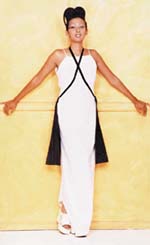 |
 1st March 1998 |
Front Page| |
Lankans need to break free from traditionTo me, the most chic person would be not someone draped in finery, but a well groomed person - says designer Andre Estefan By Dilrukshi HandunnettiFashion is all about having a personal style and poise of one's own, contrib uting to the enhancement of one's personality, claims Andre Estefan, one of the leading fashion designers in the country today.
For instance, Estefan believes that pants look nice on some, while some look splendid in flowing dresses. Without the customary designer's grudge against the traditional saree, he believes that the saree is the most alluring and erotic of garments though not exploited to make a proper fashion statement by the Asian wearer. "Colours have much to do with fashion, and so do fabric and accessories.
It is important to discover what suits each personality and bring out the
very best in each individual. A designer must first create, Early in his career, Estefan experimented with new trends- a certain influx of the West and a touch of eastern allure. In 1991, he introduced the Ethnic Rag Revolution which brought him fame as a creator of a novel trend in local fashion. Those days are over, he says with a smile. It was not because he tired of fashions which pursued an ethnic line, but he feels because the country has outlived this style, spoiling it for many decades to come. "This is why I say that Eastern people find safety in numbers. The reluctance to try out something new is such that they do not mind wearing garments with the same cut for decades. It is positively disgusting that people do not much care for presenting a better image. To me, the most chic person would be not someone draped in finery, but a well groomed person." A few years ago, designer sarongs became the height of fashion. The
duration of any fashion despite its lasting quality should be about six
months. It is necessary for the fashion industry to evolve, to take In his eyes, the Western garb did not sit quite well on eastern people. This required the adaptation of western fashions to suit the country's ethnic identity and culture both. His observation however, is that conservative societies do not necessarily have to be wary of fashion. "If you follow the Parisian or Milan trends, it does not necessarily mean that one has to be semi clad and wear transparent clothing to have that fashionable appearance. There are ways to strike a balance between modesty and elegance, Estefan asserts. In his belief, despite the restrictive features in the local fashion domain, some designers have excelled. He names Nayantara Fonseka, Mangala Innocence and Dinesh Chandrasena as those with much potential. It was indeed disheartening that there were no incentives provided to retain the creative people in the industry, he adds. "It is tragic that anyone with an opportunity to leave the shores, does it. There is little scope here with people being extremely traditional. Designers, therefore, have to churn out the same thing for many generations. The ultimate truth is that our designers mostly end up as glorified dress makers." While admitting that a designer must cater to the existing market, Estefan
feels that designers are at a "It is not the outlandish weird look I am speaking of, but the genuinely creative and different styles. But our people want the same thing their mothers and aunts wore. How could a designer develop his creativity and do new styles when the economic factor pushes him to curb it and churn out the mediocre- just to meet the market trends. In short, the present requirement of a designer is to create easy to market stuff opposed to his concept of what fashion should be." The outspoken designer is convinced that a person should master one art or trade rather than becoming a jack of all trades. It was necessary for each person to respect the other's vocation and not butt in where as in Sri Lanka many tried their hands at every possible thing. "Some try to do hair, make up, foot wear as well as the dressing. This is inevitable to a certain extent in a backward fashion world. But it destroys the professionalism in each of us," says Estefan. Yet all could not be without hope. There appeared to be a potential market for selling novel creations in Colombo and its environs, and there were healthy signs of improved fashion sense among the young people. "We require an exercise to educate the consumer where they should go for novelty and creativity, while choosing something which enhances their personal style. It is mandatory that like any other industry, for fashions to evolve. In fact, overseas it is the most evolving industry with the January trends disappearing before April. It is this swiftness which improves creativity, says Estefan with a pensive note. Commenting on the Western scene, Estefan who was here on a short holiday said that Australians were quick to change their fashions. Sydney, where he is currently residing was undergoing many changes including in the fashion industry owing to the forthcoming Sydney Olympics. For the year 1998, bright oranges, greens and blues were the colours which are in vogue, he says. Emphasis is also being given to gem studded antique jewellery with precious stones. Hair colours were wild, though not lacking soft appeal. According to Estefan, a nice below the knee length has made a come back after many years of struggling between rising and falling hemlines. "It is fashionable to wear your grandmother's gem studded pendants and the inconspicuous gem studded ear studs, he says with a smile. Chunky stuff has been replaced with diamond solitaires and emeralds, the very expensive but unobtrusive pieces. And for Estefan, despite the many drawbacks with a prolonged war and a backward fashion industry, the only permanent home for him is Sri Lanka, to which he wishes to return tonce his overseas agenda is concluded. "We have an awakening of young people here, and they seem to appreciate creativity. There is much to do and much to hope for," he says. |
||
|
More Mirror Magazine * Bevan's Perfect catch * Glycerin in Creams
Front Page| News/Comment| Editorial/Opinion| Business| Plus |Sports |
||
|
Please send your comments and suggestions on this web site to The Sunday Times or to Information Laboratories (Pvt.) Ltd. |
||
 Perched
on a stool, his tinted shoulder length mane in wild disarray, he says it
is disheartening to note that our people are still seeking safety rather
than being adventurous, fashion- wise and developing a style of one's own.
Perched
on a stool, his tinted shoulder length mane in wild disarray, he says it
is disheartening to note that our people are still seeking safety rather
than being adventurous, fashion- wise and developing a style of one's own. and
then he must dress the client to have that extra edge."
and
then he must dress the client to have that extra edge." the
boredom away. Estefan's contention is that sarongs grew in popularity mainly
due to a desire to cover imperfect physique. Its length and shapelessness
became positive assets to some sections of the people. When Indian fashions
flooded the country too, every one bought Indian clothes and after its
life span was over, were still refusing to let go, he said on a critical
note.
the
boredom away. Estefan's contention is that sarongs grew in popularity mainly
due to a desire to cover imperfect physique. Its length and shapelessness
became positive assets to some sections of the people. When Indian fashions
flooded the country too, every one bought Indian clothes and after its
life span was over, were still refusing to let go, he said on a critical
note. 'creative
disadvantage' because people were less inspired by novel trends or unique
designs.
'creative
disadvantage' because people were less inspired by novel trends or unique
designs. 
